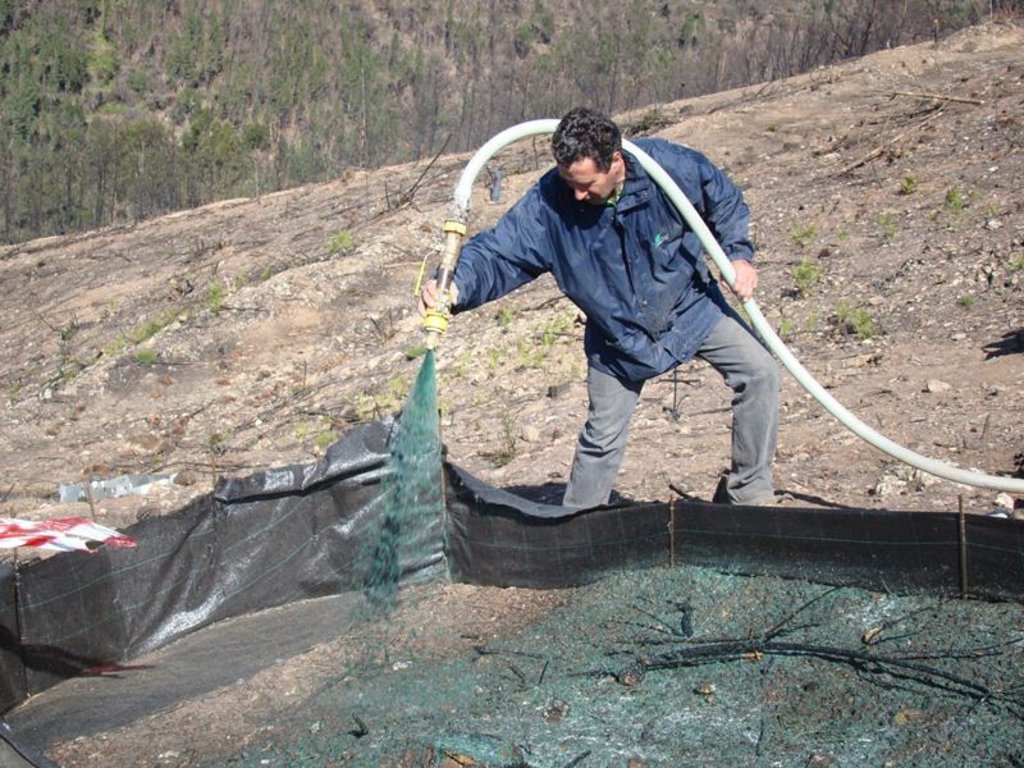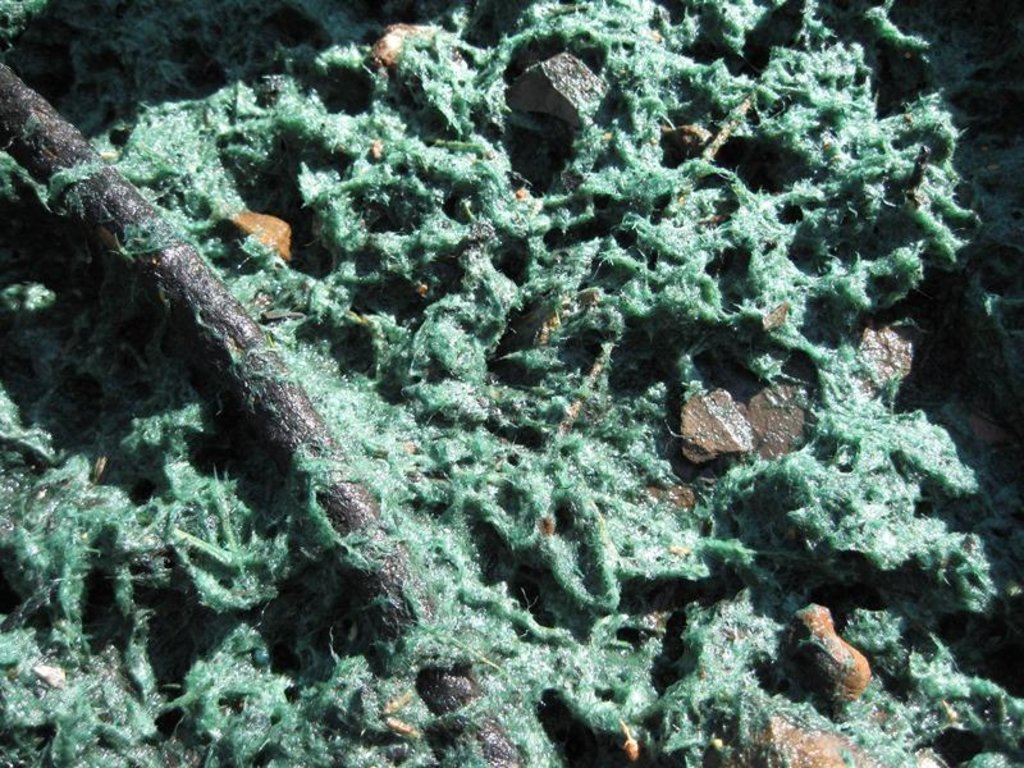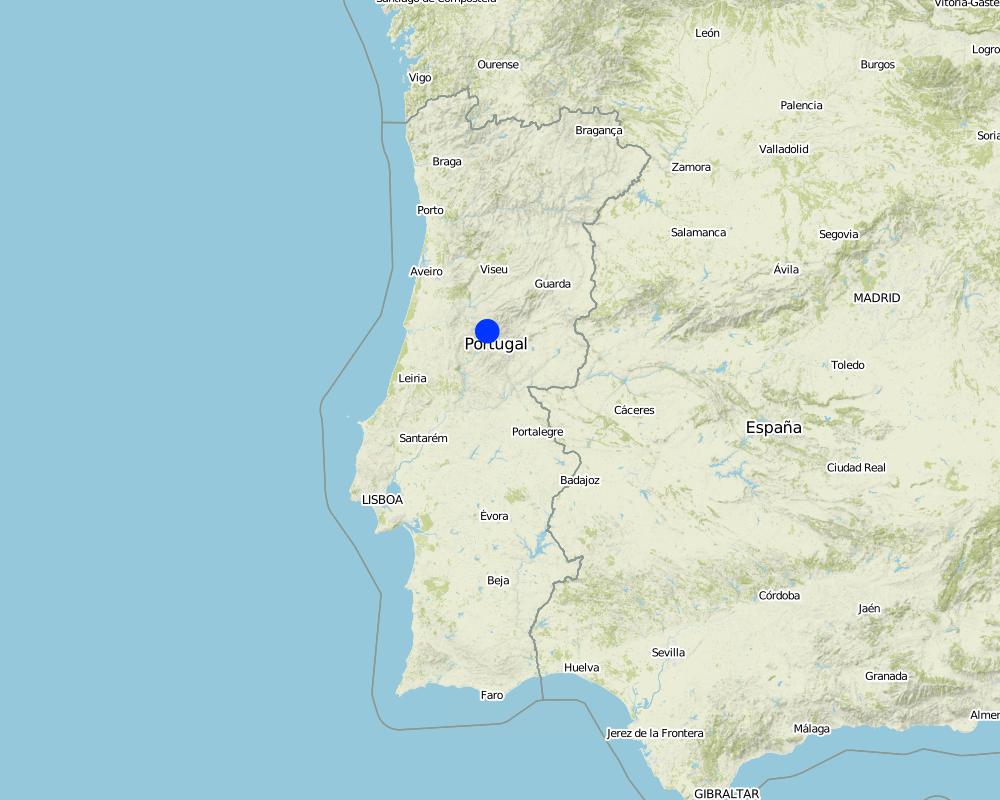Hydromulching for reducing runoff and soil erosion [Portugal]
- Creation:
- Update:
- Compiler: Sergio Prats Alegre Prats
- Editor: –
- Reviewers: Fabian Ottiger, Valentin Zuercher
Hydromulch
technologies_1299 - Portugal
View sections
Expand all Collapse all1. General information
1.2 Contact details of resource persons and institutions involved in the assessment and documentation of the Technology
SLM specialist:
SLM specialist:
SLM specialist:
Keizer Jan Jacob
Centre for Environmental and Marine Studies (CESAM) - Department of Environment and Planning-University of Aveiro
Portugal
Name of project which facilitated the documentation/ evaluation of the Technology (if relevant)
Catastrophic shifts in drylands (EU-CASCADE)Name of project which facilitated the documentation/ evaluation of the Technology (if relevant)
Preventing and Remediating degradation of soils in Europe through Land Care (EU-RECARE )Name of the institution(s) which facilitated the documentation/ evaluation of the Technology (if relevant)
Fundação para a Ciência e a Tecnologia (FCT) - PortugalName of the institution(s) which facilitated the documentation/ evaluation of the Technology (if relevant)
University of Aveiro (University of Aveiro) - Portugal1.3 Conditions regarding the use of data documented through WOCAT
The compiler and key resource person(s) accept the conditions regarding the use of data documented through WOCAT:
Yes
2. Description of the SLM Technology
2.1 Short description of the Technology
Definition of the Technology:
Hydromulch is spread immediately after a wildfire in order to reduce overland flow and prevent soil erosion.
2.2 Detailed description of the Technology
Description:
The research team of the University of Aveiro in collaboration with the fire Brigade and a private company applied the hydromulch in a burnt pine area burnt at moderate fire severity. Hydromulch was spreaded manually from a jet hose over a group of erosion plots, and both runoff and erosion were compared to an untreated group of plots.
The hydromulch was applied at a ratio of 3.5 Mg ha-1 providing an initial ground cover of 80%, and was found to reduce post-fire runoff in 70% and soil erosion in 83%.
Purpose of the Technology: Hydromulch has been particularly useful on steep slopes and strongly modified areas such as quarries, construction sites, and cut and fill slopes along roads (Robichaud et al., 2010). The hydromulch is a complex mixture which contain basically water and wood or paper fibers. Additionally it can contain seeds, surfactants, seed-growing biostimulants, nutrients and a green colorant. It is intended that each component affected some of the pieces of the post-fire runoff erosion process.
The high effectiveness in runoff reduction could be related to the effect of the wood fibers, because it increases the surface water storage capacity, but also due to the effect of the surfactants, a wetting agent that reduces SWR and increases soil infiltration. Ideally, post-fire hydromulching must be carried out immediately after the fire, over bare, unprotected and steep burnt areas. It is intended for places in which burnt severity was moderate to high and where there are very important values at risk, such as water reservoirs, populations, industries, human and wild life.
Establishment / maintenance activities and inputs: The hydromulch is applied once, immediately after the wildfire, aerially, from a tractor or also manually by using a jet hose operated by a person on foot. It basically consisted of a mixture of water, wood fibers and seeds. The seed composition should include autoctonous plant species, in order to avoid alien species into the burnt area and increase the germination success. Besides the composition, the application technique can influence the hydromulch effectiveness. Rough (2007) and Robichaud et al. (2010) reported that the hydromulch sprayed from vehicles was intercepted by the standing trees, and they recommended special caution when applying the mixture in areas with a high density of dead trees and from long distances. Aerial hydromulch can be a better and less expensive option, but Hubbert et al. (2012) checked that the intended application rates of 50% and 100% hydromulch cover resulted in only 20–26% and 56%.
Natural / human environment: The natural forest in central Portugal has been substituted by pine and eucalypt trees that are typically planted as monocultures for wood and paper pulp production. The landscape reflects a long history of intense land management, with a mosaic of (semi-) natural and man-made agricultural and afforested lands. In recent years, however, wildfires have increased dramatically in frequency and extent, and have been associated to soil fertility losses, and consequently to socio-economic losses.
2.3 Photos of the Technology
2.5 Country/ region/ locations where the Technology has been applied and which are covered by this assessment
Country:
Portugal
Region/ State/ Province:
Portugal
Further specification of location:
Gois-Colmeal
Specify the spread of the Technology:
- evenly spread over an area
If precise area is not known, indicate approximate area covered:
- < 0.1 km2 (10 ha)
Map
×2.6 Date of implementation
If precise year is not known, indicate approximate date:
- 10-50 years ago
2.7 Introduction of the Technology
Specify how the Technology was introduced:
- during experiments/ research
Comments (type of project, etc.):
Hydromulch has been particularly useful on steep slopes and strongly modified areas such as quarries, construction sites, and cut and fill slopes along roads (Emanual, 1976; Benik et al., 2003; Robichaud et al., 2010).
3. Classification of the SLM Technology
3.2 Current land use type(s) where the Technology is applied

Forest/ woodlands
Products and services:
- Timber
- Fuelwood
Comments:
Major land use problems (compiler’s opinion): Increased runoff and soil erosion, resulting in a decrease of on-site fertility and derived off-site effects such as loss of water quality, reservoirs water volume storage, higher risk of flooding and human beings damage.
Major land use problems (land users’ perception): Loss of wood resources and productivity.
Plantation forestry: Yes
Forest products and services: timber, fuelwood
Constraints of infrastructure network (roads, railways, pipe lines, power lines): price
3.5 SLM group to which the Technology belongs
- improved ground/ vegetation cover
3.6 SLM measures comprising the Technology

agronomic measures
- A3: Soil surface treatment
Comments:
Main measures: agronomic measures
Type of agronomic measures: mulching
3.7 Main types of land degradation addressed by the Technology

soil erosion by water
- Wt: loss of topsoil/ surface erosion
- Wg: gully erosion/ gullying
- Wo: offsite degradation effects

physical soil deterioration
- Pk: slaking and crusting
Comments:
Main type of degradation addressed: Wt: loss of topsoil / surface erosion
Secondary types of degradation addressed: Wg: gully erosion / gullying, Wo: offsite degradation effects, Pk: sealing and crusting
Main causes of degradation: deforestation / removal of natural vegetation (incl. forest fires) (Monoculture of forest plantations prone to forest fires)
3.8 Prevention, reduction, or restoration of land degradation
Specify the goal of the Technology with regard to land degradation:
- reduce land degradation
Comments:
Main goals: mitigation / reduction of land degradation
4. Technical specifications, implementation activities, inputs, and costs
4.1 Technical drawing of the Technology
4.2 General information regarding the calculation of inputs and costs
other/ national currency (specify):
euros
If relevant, indicate exchange rate from USD to local currency (e.g. 1 USD = 79.9 Brazilian Real): 1 USD =:
0.78
Indicate average wage cost of hired labour per day:
64.50
4.3 Establishment activities
| Activity | Timing (season) | |
|---|---|---|
| 1. | Apply hydromulch | |
| 2. | Trasportation (Track with a jet-spreading system) | |
| 3. | Other |
4.4 Costs and inputs needed for establishment
| Specify input | Unit | Quantity | Costs per Unit | Total costs per input | % of costs borne by land users | |
|---|---|---|---|---|---|---|
| Labour | Labour | ha | 1.0 | 128.2 | 128.2 | 100.0 |
| Equipment | Machine use | ha | 1.0 | 128.2 | 128.2 | 100.0 |
| Other | Hydromulch | ha | 1.0 | 3205.0 | 3205.0 | 100.0 |
| Other | Others | ha | 1.0 | 128.2 | 128.2 | 100.0 |
| Total costs for establishment of the Technology | 3589.6 | |||||
Comments:
Duration of establishment phase: 0.1 month(s)
Lifespan of the hydromulch: 1 year
4.6 Costs and inputs needed for maintenance/ recurrent activities (per year)
Comments:
The prices were determined in winter 2009 for central Portugal. In other regions and for other formulations these prices can vary. When compared with straw mulch its price is extremely high, but despite this greater expense, hydromulching has been used especially in the USA after some fires when access was difficult, the slopes were too steep or subject to wind to use straw mulch and when there were particularly important ‘values at risk’, such as water reservoirs, cultural or natural heritage sites, national or regional wildlife protected areas or industrial plants
4.7 Most important factors affecting the costs
Describe the most determinate factors affecting the costs:
Accessibility and steepness will raise the costs, but selecting hydromulchings is also a main factor. The more complex the hydromulch the more expensive the application cost. Hydromulch with seeds have also the possibility of introducing invasive plants into the ecosystems and increase the costs. For large and inaccessible areas the aerial hydromulch can reduce the costs.
5. Natural and human environment
5.1 Climate
Annual rainfall
- < 250 mm
- 251-500 mm
- 501-750 mm
- 751-1,000 mm
- 1,001-1,500 mm
- 1,501-2,000 mm
- 2,001-3,000 mm
- 3,001-4,000 mm
- > 4,000 mm
Agro-climatic zone
- sub-humid
Thermal climate class: temperate
5.2 Topography
Slopes on average:
- flat (0-2%)
- gentle (3-5%)
- moderate (6-10%)
- rolling (11-15%)
- hilly (16-30%)
- steep (31-60%)
- very steep (>60%)
Landforms:
- plateau/plains
- ridges
- mountain slopes
- hill slopes
- footslopes
- valley floors
Altitudinal zone:
- 0-100 m a.s.l.
- 101-500 m a.s.l.
- 501-1,000 m a.s.l.
- 1,001-1,500 m a.s.l.
- 1,501-2,000 m a.s.l.
- 2,001-2,500 m a.s.l.
- 2,501-3,000 m a.s.l.
- 3,001-4,000 m a.s.l.
- > 4,000 m a.s.l.
5.3 Soils
Soil depth on average:
- very shallow (0-20 cm)
- shallow (21-50 cm)
- moderately deep (51-80 cm)
- deep (81-120 cm)
- very deep (> 120 cm)
Soil texture (topsoil):
- medium (loamy, silty)
Topsoil organic matter:
- high (>3%)
If available, attach full soil description or specify the available information, e.g. soil type, soil PH/ acidity, Cation Exchange Capacity, nitrogen, salinity etc.
Soil texture is medium (sandy-loam)
Soil fertilits is high
Topsoil organic matter is high (forest soil)
Soil drainage/infiltration is poor-medium
Soil water storage capacity is low
5.4 Water availability and quality
Ground water table:
5-50 m
Availability of surface water:
medium
Water quality (untreated):
for agricultural use only (irrigation)
Comments and further specifications on water quality and quantity:
Water quality (untreated) is for agriculutral use only (surface water)
5.5 Biodiversity
Species diversity:
- low
Comments and further specifications on biodiversity:
Forest plantation
5.6 Characteristics of land users applying the Technology
Market orientation of production system:
- mixed (subsistence/ commercial)
- commercial/ market
Off-farm income:
- > 50% of all income
Relative level of wealth:
- poor
- average
Individuals or groups:
- employee (company, government)
Indicate other relevant characteristics of the land users:
Population density: < 10 persons/km2
Annual population growth: < 0.5%
40% of the land users are average wealthy.
60% of the land users are poor.
Market orientation of production system: subsistence (self-supply), mixed (subsistence/ commercial, commercial/ market
5.7 Average area of land used by land users applying the Technology
- < 0.5 ha
- 0.5-1 ha
- 1-2 ha
- 2-5 ha
- 5-15 ha
- 15-50 ha
- 50-100 ha
- 100-500 ha
- 500-1,000 ha
- 1,000-10,000 ha
- > 10,000 ha
Is this considered small-, medium- or large-scale (referring to local context)?
- large-scale
Comments:
Average area of land owned or leased by land users applying the Technology: 2-5 ha, 5-15 ha, 15-50 ha
5.8 Land ownership, land use rights, and water use rights
Land ownership:
- individual, not titled
5.9 Access to services and infrastructure
health:
- poor
- moderate
- good
education:
- poor
- moderate
- good
technical assistance:
- poor
- moderate
- good
employment (e.g. off-farm):
- poor
- moderate
- good
markets:
- poor
- moderate
- good
energy:
- poor
- moderate
- good
roads and transport:
- poor
- moderate
- good
drinking water and sanitation:
- poor
- moderate
- good
financial services:
- poor
- moderate
- good
6. Impacts and concluding statements
6.1 On-site impacts the Technology has shown
Socio-economic impacts
Production
wood production
Water availability and quality
water availability for livestock
Socio-cultural impacts
SLM/ land degradation knowledge
Improved livelihoods and human well-being
Comments/ specify:
Livelihoods and human well-being (eg education, health) are not changed by the use of Hydromulching.
Ecological impacts
Water cycle/ runoff
water quantity
surface runoff
groundwater table/ aquifer
evaporation
Soil
soil moisture
soil cover
soil loss
soil crusting/ sealing
Biodiversity: vegetation, animals
invasive alien species
Comments/ specify:
If hydromulching is with seeds, it can introduce invasive species
6.2 Off-site impacts the Technology has shown
downstream flooding
damage on neighbours' fields
damage on public/ private infrastructure
6.3 Exposure and sensitivity of the Technology to gradual climate change and climate-related extremes/ disasters (as perceived by land users)
Gradual climate change
Gradual climate change
| Season | increase or decrease | How does the Technology cope with it? | |
|---|---|---|---|
| annual temperature | increase | well |
Climate-related extremes (disasters)
Meteorological disasters
| How does the Technology cope with it? | |
|---|---|
| local rainstorm | well |
| local windstorm | well |
Climatological disasters
| How does the Technology cope with it? | |
|---|---|
| drought | well |
Hydrological disasters
| How does the Technology cope with it? | |
|---|---|
| general (river) flood | not known |
Other climate-related consequences
Other climate-related consequences
| How does the Technology cope with it? | |
|---|---|
| reduced growing period | well |
6.4 Cost-benefit analysis
How do the benefits compare with the establishment costs (from land users’ perspective)?
Short-term returns:
negative
Long-term returns:
neutral/ balanced
How do the benefits compare with the maintenance/ recurrent costs (from land users' perspective)?
Short-term returns:
positive
Long-term returns:
very positive
Comments:
Hydromulch is seen as a very expensive treatment without clear advantages at the short term, but good at the long term period.
6.5 Adoption of the Technology
Comments:
Comments on spontaneous adoption: The technology has not been applied by any land user. It is a newly research-developed technology.
There is no trend towards spontaneous adoption of the Technology
Comments on adoption trend: The owners are not aware because of the costs, but they will change if the government start funding it.
6.7 Strengths/ advantages/ opportunities of the Technology
| Strengths/ advantages/ opportunities in the land user’s view |
|---|
|
It will prevent sediment movement and accumulation over roads and down slope properties and values at risk. How can they be sustained / enhanced? By developing more economic application formulations and schemes. |
| Strengths/ advantages/ opportunities in the compiler’s or other key resource person’s view |
|---|
|
It is a technology that has the advantages of the mulching technique and also can be used as a tool for increase the biodiversity, expand the distribution of some protected plant species at the same time that soil is keep in place. How can they be sustained / enhanced? The use of longer mulch fibers can still increase the hydromulch effectiveness, since some researchers found the longest fibers to be more effective in soil erosion control than the shorter ones. |
6.8 Weaknesses/ disadvantages/ risks of the Technology and ways of overcoming them
| Weaknesses/ disadvantages/ risks in the compiler’s or other key resource person’s view | How can they be overcome? |
|---|---|
| Hydromulch is very expensive when compared to straw mulch, but not more effective in post-fire soil erosion reduction. | To develop hydromulch mixtures using the lowest amount of water as well as other chemical components to the minimum. |
| Some researchers found very low performance due to the interception of the hydromulch jet by the dead standing trees | Verify when applying it that the ground coverreach a minimum of 60% |
| Sometimes the mulch component (wood fibers, chopped paper) can be removed very easily by heavy rainfall, and thus treatment effectiveness can decrease greatly. |
7. References and links
7.1 Methods/ sources of information
7.2 References to available publications
Title, author, year, ISBN:
EFFECTIVENESS OF HYDROMULCHING TO REDUCE RUNOFF AND EROSION
IN A RECENTLY BURNT PINE PLANTATION IN CENTRAL PORTUGAL. Prats et al. (in press). Land Degradation and Development DOI: 10.1002/ldr.2236
2-Effects of hydromulch on post-fire erosion and plant recovery in chaparral shrublands of
southern California. Hubbert et al. 2012 International Journal of Wildland Fire 21:155–167.
Rough D. 2007. Effectiveness of rehabilitation treatments in reducing postfire
erosion after the Hayman and Schoonover fires, Colorado Front
Range. Fort Collins, CO: Colorado State University. MsC. Thesis; 186.
Robichaud PR, Ashmun LE, Sims BD. 2010. Post-fire treatment effectiveness
for hillslope stabilization. General Technical Report, RMRS-GTR-240. U.
S. Department of Agriculture, Forest Service, Rocky Mountain Research
Station, Fort Collins, CO.
Links and modules
Expand all Collapse allLinks
No links
Modules
No modules






